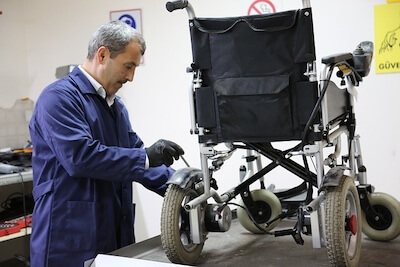Assess the Leadership Performance of Your Small Nonprofit
- Home
- Small Nonprofit Practices
- Assess the Leadership Performance of Your Small Nonprofit
Assess the leadership performance of your small nonprofit. Take time to review your organization's attitude to leadership.
This will help you decide on areas of where improvement might be helpful for the future good of your organization. Since attitudes determine actions, don't pass over this section.
9. Leadership Style is Appropriate for the Stage the Organization Is At

This is Practice 9 of 80
Starting an organization from nothing and taking over an organization with established procedures and large numbers of long-time staff require different types of leadership styles.
The size of the organization makes a difference. Age of the organization, demographics, and needs of those served, are all determining factors. Public opinion and internal challenges make a difference. There are styles of leadership that work best in different situations.
If We Were Coaching Together I Would Ask This
- What stage is your organization at?
- What kind of leadership style might this stage call for?
- How is your current leadership style performing?
- How adaptable have you been with leadership styles, or has a paralysis of style set in?
- What may need to change in style to allow the organization to move ahead?
Why This Practice is Important to Me As a Leadership Coach
Different situations require different approaches. I was Executive Director in an organization where I followed the Founder. His style of leadership was what was needed for starting a nonprofit, creating infrastructure and interest, and building it up in those early years.
Fast forward a few years, where there was reasonably established infrastructure. What we had gained was a lot of volunteers who continued to give of themselves over years. This required a style of leadership that was comfortable interacting with people, listening to their ideas and challenges, and "setting them loose" to do their part in the mission.
In my coaching experience, there have been times where the organization had grown but the leadership hadn't responded to the new realities. In my example, a founding mindset might not be as effective as the team matures. You could apply this to all sorts of leadership requirements, and that's the way you must examine your organization.
And, that's why I have you assess the leadership performance of your small nonprofit. It may be great. But, it also may be in need of a revamp.
The Key Concept, Attitude or Action That Drives This Practice
ADAPTABLE
Leadership must be adaptable to make changes. Inflexibility may lose staff and cease to attract those you want to serve.
Remember Jesus feeding the 5000 people? The disciples said, "Send the crowds away." Jesus said, "Give them something to eat." It isn't "get the basics done (teaching, healing,) and send them home." It's "give them something to eat." Two different leadership styles in contrast.
An Expansive Thought
Sensing the winds of change and responding to them before they become apparent is a sign of wise leadership.
An Action Point
Be thankful if your style of leadership is still appropriate for the current needs of your organization. If it isn’t, start to take the steps to change it.
10. The Organization Supports
Leadership Development

This is Practice 10 of 80
If you want good leaders, put resources into leadership development. Then make sure you can measure and get a return on that development.
Workshops, groups, books, courses, in-house training, and many other available resources that can be accessed by your leaders will broaden their knowledge and possibilities and deepen their value to the organization.
Don’t leave your leaders without funding and support for the tools to make them better leaders. Encourage it as a matter of course.
If We Were Coaching Together I Would Ask This
- What do you currently have in place to train and develop your leaders?
- If you have one, how often do you review your plan to better develop your leaders.
- How do you determine your budget for such development?
- How much is enough?
- What guidance do you give emerging leaders to assist them in getting what they can best use now, at this stage of their growth?
Why This Practice is Important to Me as a Leadership Coach
Putting the effort and resources into developing your staff will deepen their value and contributions to the aims of the organization. I've seen too many small nonprofits that seem to "look for warm bodies" and put them into positions of leadership. This often occurs on small nonprofit boards. Not a lick of training for how to actually be a high-contributing board member.
They get willing and good hearted people to serve. But, those people get little to no training or development. They're "flying be the seat of their pants." And we expect them to do an important job ... often working with people, for which they are basically ill equipped.
Sure, they'll do the best they can, but they would so much appreciate some growth opportunities so they can do even better. Sadly, this is a story I hear over and over again. And some organizations give an hour or two of training and that's it for the season or year. C'mon, that's risky.
The Key Concept, Attitude or Action That Drives This Practice
STRENGTHEN
Strengthen your organization by intentionally investing in its people. Remember the amount of time the Lord poured into those disciples, and what happened there.
An Expansive Thought
A few days of training and development once in a while is great, but year-round attention to an intentional plan of growth is by far better.
An Action Point
Have each leader develop a personal plan of development. Review it with them. Support them in their goals. How are you doing as you assess the leadership performance of your small nonprofit?
11. Senior Staff Have a Proven Record
of Servant Leadership

This is Practice 11 of 80
In small organizations, workers respect servant leadership - leaders who have been where they are, and who know what they are going through.
They respect men and women who have a track record of serving.
No ivory tower stuff here … Staff, especially volunteers, respond to leaders who role model what it is to be a worker. Find a leader who spends their time trying to get out of work and you will find a demoralized staff.
If We Were Coaching Together I Would Ask This
- In what ways has the senior leadership ever been out in the trenches and gotten into the work with the rest of the staff?
- How visible, in a positive way, is the senior leadership to the rest of the staff?
- How have you traditionally chosen senior leadership?
- What changes in attitude or approach need to be made?
Why This Practice is Important to Me as a Leadership Coach
Staff will respond with loyalty to senior leaders who work with them, not lord over them. I understand that in some leadership roles, it's hard to always be out with the team. But when the leader (Executive Director or Project Leader, or whatever your title is) isn't seen doing much of anything as others do the work, it's disastrous for morale.
Prove you can work. Understand what volunteers experience. Work alongside them. Enjoy their company. Find out about them. Listen to their ideas and observations. It's amazing what you'll learn ... and how you will grow.
I've coaching in situations where the leader seems to hold the attitude they are the "overseer" only. That doesn't seem like servant leadership to me, nor does it come across as "being a part of it" with the team.
The Key Concept, Attitude or Action that Drives This Practice
SERVANTHOOD
Find an attitude of servanthood and you will have found the best example of leadership. Remember the Lord, who said, "the Son of Man did not come to be served, but to serve, and to give his life as a ransom for many." Matthew 20:28
People pretty quickly pick up on a leader who is trying to get out of work and being self-serving. They also pick up quickly on the leaders who give of themselves in self-sacrificial ways.
An Expansive Thought
Day after day, leaders who know how to work effectively serve as models to all emerging leaders under them.
An Action Point
Review how you have traditionally chosen senior leadership. Articulate principles of servanthood to guide you in making such choices.
12. The Organization's Leaders Have a
Passion for Excellence

This is Practice 12 of 80
Too many people equate talking about excellence with something like buying the most expensive of everything. That is not the case at all. Doing the very best we can is an attitude of excellence.
Buying a commercial vacuum because a household one won’t take the wear and tear may also reflect this attitude. Wanting to measure the success of a retreat so it can be made better next year reflects the pursuit of this quality.
If We Were Coaching Together I Would Ask This
- How serious and committed are your organization’s leaders in wanting things to improve month to month, year to year?
- What is the prevailing attitude about the pursuit of "excellence," and how is this attitude articulated for the whole organization?
It’s not about the amount of money spent. It is about the attitude toward spending it and about a whole lot of other things we do and say .... with excellence.
Why This Practice is Important to Me as a Leadership Coach
People want to be part of an organization that is striving to be its best. I've had the privilege of coaching in organizations where the leaders strive to improve on themselves and their performance, year over year (or on an even faster frequency).
They are intentional. That's probably why they retained me as an Executive Coach in the first place. They known they can do better, not in a remedial way, but simply "up their game," and they take focused action to make it happen.
The Key Concept, Attitude or Action That Drives This Practice
PASSION
The attitude of the leadership will be directly reflected in the attitude of the people who work with those you serve. "Whatever you do, work at it with all your heart, as working for the Lord." Colossians 3:23
An Expansive Thought
Carefully pick your leadership because they want to do things really well (not perfectionism) and you will see greater results from your organization.
An Action Point
Ask whether your organization has slipped into a 'that's good enough' mode. If you took the time to assess the leadership performance of your small nonprofit, and you find yourself saying, "that's good enough," stop right now and think about what you just said.
End of, Assess the Leadership Performance of Your Small Nonprofit. Continue to "Develop Leadership Best Practices for Your Small Nonprofit," for the next four insights to help you decide on areas for improvement in your organization.
What Do You See When You Assess the Leadership Performance of Your Small Nonprofit?
If you have found stopping to assess the leadership performance of your small nonprofit helpful, consider moving on to Part Two, Develop Leadership Best Practices for Your Small Nonprofit.
Or, if you are in senior leadership, and would like to work with an Executive Coach, reach out here and connect. We can have a conversation about your needs.
Contact me here Privacy Policy
© G.E.Wood and Associates. All Rights Reserved in all media.
G.E. Wood and Associates is an international coaching firm registered in Ontario, Canada
142 Pratt Crescent, Gravenhurst, Ontario, Canada, P1P 1P5